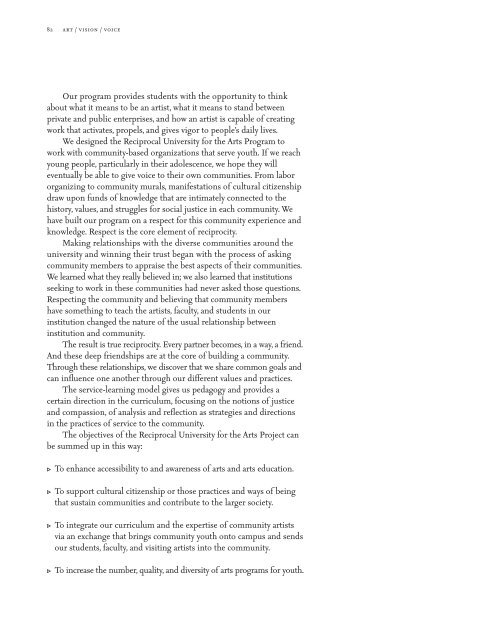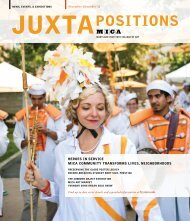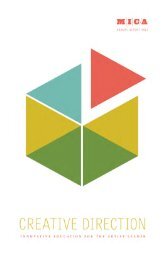art/vision/voice - Maryland Institute College of Art
art/vision/voice - Maryland Institute College of Art
art/vision/voice - Maryland Institute College of Art
Create successful ePaper yourself
Turn your PDF publications into a flip-book with our unique Google optimized e-Paper software.
82 <strong>art</strong> / <strong>vision</strong> / <strong>voice</strong><br />
Our program provides students with the opportunity to think<br />
about what it means to be an <strong>art</strong>ist, what it means to stand between<br />
private and public enterprises, and how an <strong>art</strong>ist is capable <strong>of</strong> creating<br />
work that activates, propels, and gives vigor to people’s daily lives.<br />
We designed the Reciprocal University for the <strong>Art</strong>s Program to<br />
work with community-based organizations that serve youth. If we reach<br />
young people, p<strong>art</strong>icularly in their adolescence, we hope they will<br />
eventually be able to give <strong>voice</strong> to their own communities. From labor<br />
organizing to community murals, manifestations <strong>of</strong> cultural citizenship<br />
draw upon funds <strong>of</strong> knowledge that are intimately connected to the<br />
history, values, and struggles for social justice in each community. We<br />
have built our program on a respect for this community experience and<br />
knowledge. Respect is the core element <strong>of</strong> reciprocity.<br />
Making relationships with the diverse communities around the<br />
university and winning their trust began with the process <strong>of</strong> asking<br />
community members to appraise the best aspects <strong>of</strong> their communities.<br />
We learned what they really believed in; we also learned that institutions<br />
seeking to work in these communities had never asked those questions.<br />
Respecting the community and believing that community members<br />
have something to teach the <strong>art</strong>ists, faculty, and students in our<br />
institution changed the nature <strong>of</strong> the usual relationship between<br />
institution and community.<br />
The result is true reciprocity. Every p<strong>art</strong>ner becomes, in a way, a friend.<br />
And these deep friendships are at the core <strong>of</strong> building a community.<br />
Through these relationships, we discover that we share common goals and<br />
can influence one another through our different values and practices.<br />
The service-learning model gives us pedagogy and provides a<br />
certain direction in the curriculum, focusing on the notions <strong>of</strong> justice<br />
and compassion, <strong>of</strong> analysis and reflection as strategies and directions<br />
in the practices <strong>of</strong> service to the community.<br />
The objectives <strong>of</strong> the Reciprocal University for the <strong>Art</strong>s Project can<br />
be summed up in this way:<br />
v To enhance accessibility to and awareness <strong>of</strong> <strong>art</strong>s and <strong>art</strong>s education.<br />
v To support cultural citizenship or those practices and ways <strong>of</strong> being<br />
that sustain communities and contribute to the larger society.<br />
v To integrate our curriculum and the expertise <strong>of</strong> community <strong>art</strong>ists<br />
via an exchange that brings community youth onto campus and sends<br />
our students, faculty, and visiting <strong>art</strong>ists into the community.<br />
v To increase the number, quality, and diversity <strong>of</strong> <strong>art</strong>s programs for youth.
















